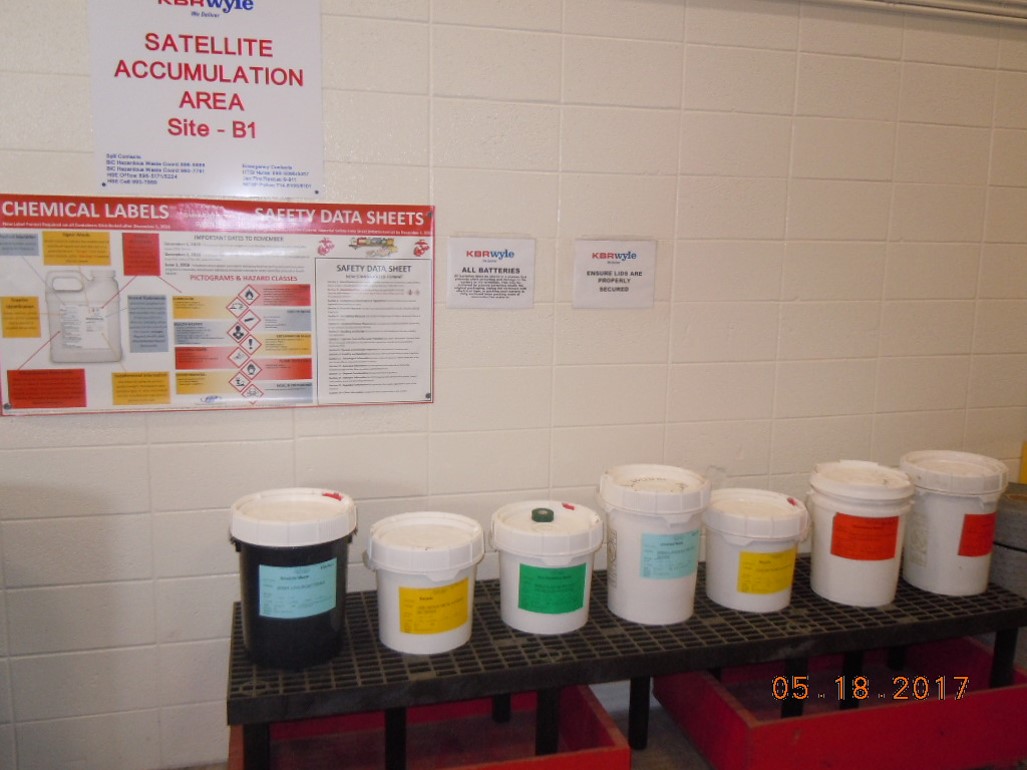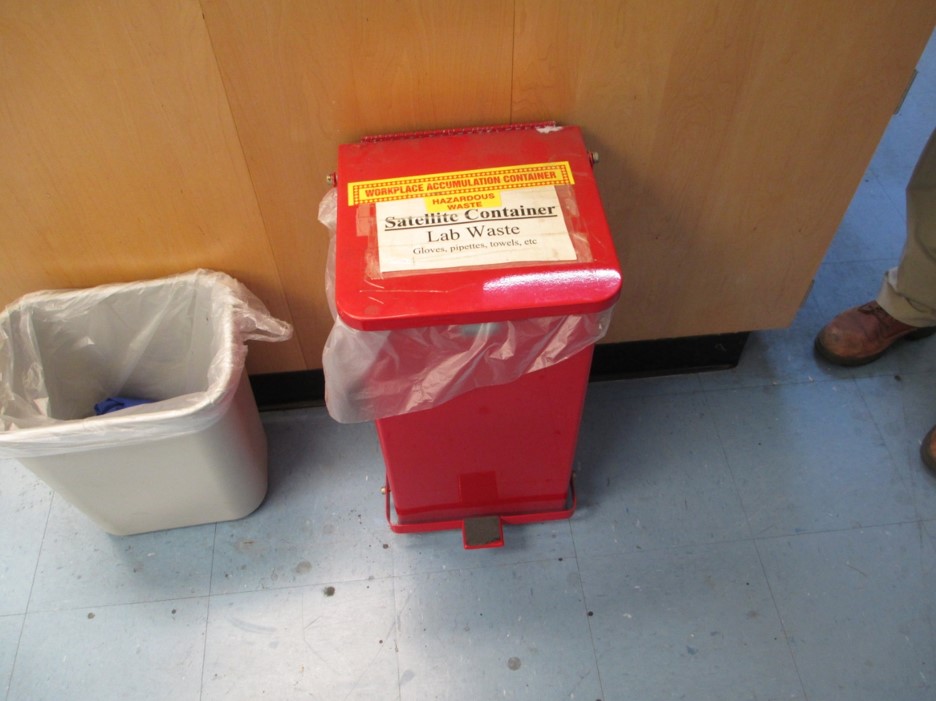Generators who accumulate hazardous waste in a satellite accumulation area (SAA) are likely familiar with the requirement to remove waste from the SAA to the central accumulation area (CAA) when the threshold volume is reached. A generator may also be aware this must be done within three (3) days. The previous SAA regulations at 40 CFR 262.34(c)(2) vaguely indicated this removal be accomplished, “within three days”. Under the Generator Improvements Rule, the USEPA amended the regulations to replace the term “three days” with “three consecutive calendar days”.

USEPA Clarifies “three days” for Removal of Hazardous Waste From Satellite Accumulation Area to Central Accumulation Area

Last Day to Submit Paper Uniform Hazardous Waste Manifests is June 30, 2021
On and after July 1, 2021, the United States Environmental Protection Agency (EPA), will no longer accept paper uniform hazardous waste manifests by mail. All hazardous waste manifests must be submitted to the EPA electronically using the e-Manifest system. Paper manifests and any continuation sheets mailed to the EPA after June 30, 2021, will be returned to the sender.
To meet the Federal requirements for submitting manifests, treatment, storage, and disposal facilities can submit paper manifests from hazardous waste generators by:
- Uploading an image of the paper manifest (image upload) or
- Uploading a data file plus image copy of the paper manifest (data plus image upload).
Hazardous waste generators who have not yet created an account in RCRAInfo for e-Manifesting are encouraged to do so as part of the transition. See the following resources for e-Manifesting and tracking:
- EPA e-Manifest Frequently Asked Questions
- RCRAInfo User Web Access
- RCRAInfo Industry Application Help and Guidance for creating an account.
For question on e-Manifests, please contact:
- EPA e-Manifest Helpdesk: HelpDesk@EPAcdx.net, or 833-501-6826
Contact me with any questions you may have about the generation, identification, management, and disposal of hazardous waste Daniels Training Services, Inc. 815.821.1550 |
For more articles on the e-Manifest System:
- History of the e-Manifest System
- The Regulations of the e-Manifest System
- FAQ: How is the Driver Supposed to sign the e-Manifest?
The EPA began accepting hazardous waste manifests electronically using the e-Manifest system on July 1, 2018. At the launch, phase-out of the paper manifest option was targeted for June 30, 2021. The EPA has allowed submittal of paper, electronic, and hybrid (electronic and paper) manifests since launch, and has seen a significant decrease in the number of paper manifests submitted. Nationally only a few facilities continue to mail paper manifests, and the EPA is working with them to transition. Using the e-Manifest system will help reduced the EPA costs associated with processing paper manifests.
Closed Containers in the Satellite Accumulation Area
Prior to the Generator Improvements Rule the regulations for generators accumulating hazardous waste in a satellite accumulation area (SAA) required containers accumulating hazardous waste to be kept closed except when necessary to add or remove waste. Under the new rule, hazardous waste containers in a SAA may remain open under limited circumstances.
The purpose of this article is to explain the regulations at 40 CFR 262.15(a)(4) that allow for limited exceptions to the closed container requirements in a satellite accumulation area. (more…)

Special Requirements for Incompatible Wastes and Materials in Satellite Accumulation Area
When first developing the satellite accumulation area (SAA) regulations in 1984 (hello Knight Rider!) the U.S. Environmental Protection agency (USEPA) inadvertently failed to account for the small quantity generators (SQG) and large quantity generators (LQG) of hazardous waste that might accumulate incompatible waste in a SAA. In the Generator Improvements Rule it fixed this oversight.
The purpose of this article is to explain the regulations of 40 CFR 262.14(a)(3) – created by the Generator Improvements Rule – that now require SQGs and LQGs to comply with special requirements for incompatible wastes accumulated in a satellite accumulation area. (more…)

Marking and Labeling of Hazardous Waste Accumulation Units Under the Generator Improvements Rule
The Generator Improvements Rule (effective 05.30.17 in the regulations of the U.S. Environmental Protection Agency and states without an authorized hazardous waste program) will make many changes to the regulations applicable to a generator of hazardous waste.
Read here for more information:
- Summary of the Generator Improvements Rule
- States and Authorized Hazardous Waste Programs
- USEPA Fact Sheet About the Hazardous Waste Generator Improvements Final Rule
The purpose of this article is to identify and explain the USEPA regulations created by the Generator Improvements Rule that require additional hazard communication on various hazardous waste accumulation units throughout the cradle-to-grave management of hazardous waste. (more…)
“An Indication of the Hazards of the Contents”: Mark and Label Hazardous Waste Containers in a Satellite Accumulation Area Under the Generator Improvements Rule
Both the large quantity generator (LQG) and small quantity generator (SQG) of hazardous waste are required by Federal regulations of the United States Environmental Protection Agency (USEPA) to display hazard communication in the form of marks and labels on the hazardous waste accumulation units in use at their facility. This includes containers of hazardous waste in both the central accumulation area (CAA) and satellite accumulation area (SAA).
These – and other – Federal regulations changed with the effective date of the Generator Improvements Rule on May 30, 2017. Regulations now require the generator to indicate the hazards of the contents in addition to other required marks and labels.
The purpose of this article is to identify and explain the requirements of the Generator Improvements Rule for the display of hazard communication on hazardous waste containers in a satellite accumulation area per 40 CFR 262.15. (more…)

Satellite Accumulation of Hazardous Waste Under the Generator of Improvements Rule
The option to manage hazardous waste in a satellite accumulation area (SAA) in addition to or instead of a central accumulation area (CAA) is available to both the large quantity generator of hazardous waste (LQG) and small quantity generator of hazardous waste (SQG). When accumulated in a SAA hazardous waste containers are subject to less regulation than when accumulated in a CAA.
Not sure of your hazardous waste generator category? |
The Generator Improvements Rule made some changes to the regulations for the accumulation of hazardous waste in a satellite accumulation area.
- Moved them from their former location at 40 CFR 262.34(c) to 40 CFR 262.15. Reorganization of Federal Regulations According to the New Generator Improvements Rule
- Made several revisions to the regulations for accumulation and management of hazardous waste in a SAA.
The purpose of this article is to provide one source for the series of articles I will write identifying and explaining the changes made by the Generator Improvements Rule to the regulations for the accumulation of hazardous waste in a satellite accumulation area (SAA).
Before we begin…
The changes:
The U.S. Environmental Protection Agency (USEPA) proposed six changes to the regulations for SAAs. In addition to these six proposed regulatory changes, USEPA discussed two additional issues in the preamble to the proposed rule. In the end, USEPA finalized the six proposed changes with three additional minor changes for a total of nine regulatory changes. It also took non-regulatory actions based on the two issues addressed in the preamble.
The nine changes to the satellite accumulation area regulations by the Generator Improvements Rule are:
- Compliance with special requirements for incompatible wastes.
- Limited exceptions to closed container requirements.
- Clarify “three days” for removal of excess waste from SAA.
- Allow for volume or weight limit for acute hazardous waste.
- Clarify regulations when maximum volume (or weight) is exceeded.
- Containers must indicate the hazards of the contents.
- Applicability of preparedness, prevention, and emergency procedures.
- “Immediately” added to regulations for transfer of leaking containers.
- Clarify the SAA is an option for compliance for both LQG and SQG.
The two non-regulatory actions pertaining to SAAs are:
- Rescind the January 13, 1988 memo that allowed a storage shed outside of a building where a reactive hazardous waste is initially generated to be considered a SAA.
- Provide examples to help generators better understand the term “under the control of the operator”.
If you like this article, please share it using any of the social media platforms identified at the bottom of this article. |
Conclusion:
If you use SAAs for the on-site accumulation of hazardous waste, your Hazardous Waste Personnel Training must include them. Otherwise, you run the risk of a violation of Federal or State regulations. Contact me for the training you are required to provide to Hazardous Waste Personnel regardless of your generator category.
Daniels Training Services, Inc. 815.821.1550 |

Q&A: Can I cure, process, then dispose universal waste paint in the garbage? Asking for a friend in Texas.
A question from the Lone Star State August 12, 2020:
Hi Daniel,
I have a question pertaining to the PPRW. We are SQH and I have been trying to figure out if it’s ok to Cure, process, and then dispose of our paint that is classified as UW in the garbage. Some people are saying yes that this is allowed but I can not seem to find where the information and code for this is.
I would greatly appreciate your help and advice.
Note: PPRW = Universal Waste Paint and Paint-Related Waste |
Note: SQH = Small Quantity Handler of universal waste |
Must have been snagged by my spam filter because I didn’t reply until August 18th:
I can assist you. Question: What state are you in?
The reply:
Hi Daniel,
I am in Texas
Daniels Training Services, Inc. 815.821.1550 |
Now that I was sure I could reply:
I will answer your questions below.
- No.
- As the generator of a waste you must determine if it is a hazardous waste.
- If a hazardous waste, you have the option (in Texas) to manage PPRW as a universal waste.
- Universal waste paint & paint-related waste is unique to Texas. It is not recognized by Federal regulations of USEPA. Some states have similar universal waste types, e.g., oil-based finishes in Pennsylvania, but not nearly as broad as that of Texas.
- If you choose to manage as a universal waste instead of hazardous waste you must then manage it subject to Texas universal waste regulations.
- Texas regulations at 30 TAC 335.261(b)(18) read: (a small quantity handler of universal waste is…) “Prohibited from diluting or treating universal waste, except when responding to releases…”
- What you describe would be considered treatment and is not allowed.
- Also, universal waste may only be sent to another handler or to a destination facility, not a solid waste landfill.
- Please refer to this article I wrote summarizing the requirements for management of Paint and Paint Related Waste as Universal Waste in Texas.
I hope this helps. Please contact me with any other questions.
Conclusion:
I did not hear back from them. It may not have been the answer they wanted, but it does inform them of what they must do to comply with the regulations of the TCEQ for Texas.
Contact me the next time hazardous waste generator USEPA training is due to expire. |
Though I’m based in Illinois, I conduct training all over the country and have been to Texas for training several times. If travel costs are a limiting factor (my Onsite Training includes reimbursement for my travel costs) the same training can be provided by a live interactive webinar.

FAQ: What is the satellite accumulation area (SAA)?
The Federal regulations of the U.S. Environmental Protection Agency (USEPA) and those of all states limit the amount of time a hazardous waste generator may accumulate hazardous waste on-site without requiring a permit for the facility to operate as a treatment, storage, or disposal facility (TSDF). In general, the on-site accumulation time limits for hazardous waste in a central accumulation area (CAA) are as follows:
- Large quantity generator (LQG) is allowed no more than 90 days for the on-site accumulation of its hazardous waste. A 30-day extension may be granted in extreme situations.
- Small quantity generator (SQG) is allowed no more than 180 days for the on-site accumulation of its hazardous waste. This may be extended up to 270 days if the TSDF the SQG must use is 200 miles away or more. A 30-day extension may be granted in extreme situations.
- Very small quantity generator (VSQG) has no on-site accumulation time limit for its hazardous waste.
Not sure of your hazardous waste generator category? |
If you look for the SAA regulations at their old location of 40 CFR 262.34(c), you won’t find them. The Generator Improvements Rule – along with other revisions – changed the location of the SAA regulations to 40 CFR 262.15. Read: Reorganization of the Federal Regulations According to the Generator Improvements Rule
The LQG and SQG have the option to manage their hazardous waste in a satellite accumulation area where it is subject to less regulation. The VSQG has no use for SAAs since it is already subject to a lower-level of regulation than either the LQG or SQG. Examples of less regulation within a SAA v. CAA include:
- Hazardous waste personnel training for a LQG at 40 CFR §262.17(a)(7) is not applicable to personnel who manage hazardous waste solely within a SAA.
- Weekly inspections for both LQG [§262.17(a)(v)] and SQG [§262.16(b)(iv)] are not required for hazardous waste containers in a SAA.
- The RCRA air emission standards for a LQG at §264/§265, Subpart CC are not applicable to hazardous waste containers in a SAA.
- In the not-so-distant past (before May 30, 20217), the regulations for preparedness, prevention, and emergency procedures for both LQG and SQG were not applicable to hazardous waste accumulated in a satellite accumulation area. However, under the revised regulations of the Generator Improvements Rule, this has now changed.
- And, of course, the most significant benefit to a hazardous waste generator for accumulating hazardous waste containers in a SAA: no on-site accumulation time limit – unless you operate in California!
In its Final Rule of the Generator Improvements Rule, USEPA included a succinct description of the SAA [November 28, 2016; 81 FR 85762]:
Hazardous waste generators are allowed, though not required, to use SAAs, provided that they comply with the regulations for their use. SAAs are designed to assist generators who generate and accumulate small amounts of hazardous waste in different areas of their facility. Alternatively, SQGs and LQGs may choose to accumulate hazardous waste only in CAAs rather than in SAAs. If a SQG or LQG does choose to accumulate hazardous waste in a SAA, the generator may accumulate a limited amount of hazardous waste within each SAA. Once that threshold is reached, the SQG or LQG must transfer the hazardous waste to a CAA. Alternatively, a generator may accumulate hazardous waste within a SAA and never move the waste to a CAA once the threshold is reached, but instead, ship the waste directly off site to a RCRA designated facility (e.g., a TSDF).
Limitations and restrictions when accumulating hazardous waste in a SAA include:
- The only allowed hazardous waste accumulation unit is the container. No tanks, drip pads, or containment buildings.
- Container must be under the control of the operator generating the waste.
And…
- At or near the initial point of generation.
- May accumulate no more than 55 gallons of hazardous waste in a SAA.
And…
- May accumulate no more than 1 L or 1 kg of acute hazardous waste in a SAA.
- When the threshold volume is reached the generator has three consecutive calendar days to remove the excess amount from the SAA to the CAA or transport off-site.
Contact me with any questions you may have about the generation, identification, management, and disposal of hazardous waste Daniels Training Services, Inc. 815.821.1550 |
Conclusion:
The satellite accumulation area (SAA) may be used as an option for on-site accumulation of hazardous waste in containers at a LQG or SQG. No option exists for the LQG to provide initial Hazardous Waste Personnel training with an annual review to its employees who work with or manage hazardous waste – except, of course, for those whose only exposure to hazardous waste is in a satellite accumulation area.

The Requirements of 40 CFR 262.16(b)(9)(iv) Respond to Emergencies at Small Quantity Generator of Hazardous Waste
Federal regulations of the U.S. Environmental Protection Agency (USEPA) require a small quantity generator of hazardous waste (SQG) to maintain equipment and processes to prevent a hazardous waste emergency and to respond to it if one occurs. The regulations are found in the following SQG conditions for exemption:
- 40 CFR 262.16(b)(8) Preparedness and prevention
- 40 CFR 262.16(b)(9) Emergency procedures
This article is the tenth – and final – in a series that closely examines and explains these regulations.
In the previous article in this series I addressed the requirements of 40 CFR 262.16(b)(9)(iii) Ensure Familiarity with Emergency Procedures at a Small Quantity Generator. That was the third of the Emergency Procedures requirements of §262.16(b)(9). This article addresses the fourth and final.
The purpose of this article is to identify and explain: 40 CFR 262.16(b)(9)(iv) Ensure familiarity with emergency procedures at small quantity generator of hazardous waste. (more…)

